Khomani San Communal Property Association promotional information
Location
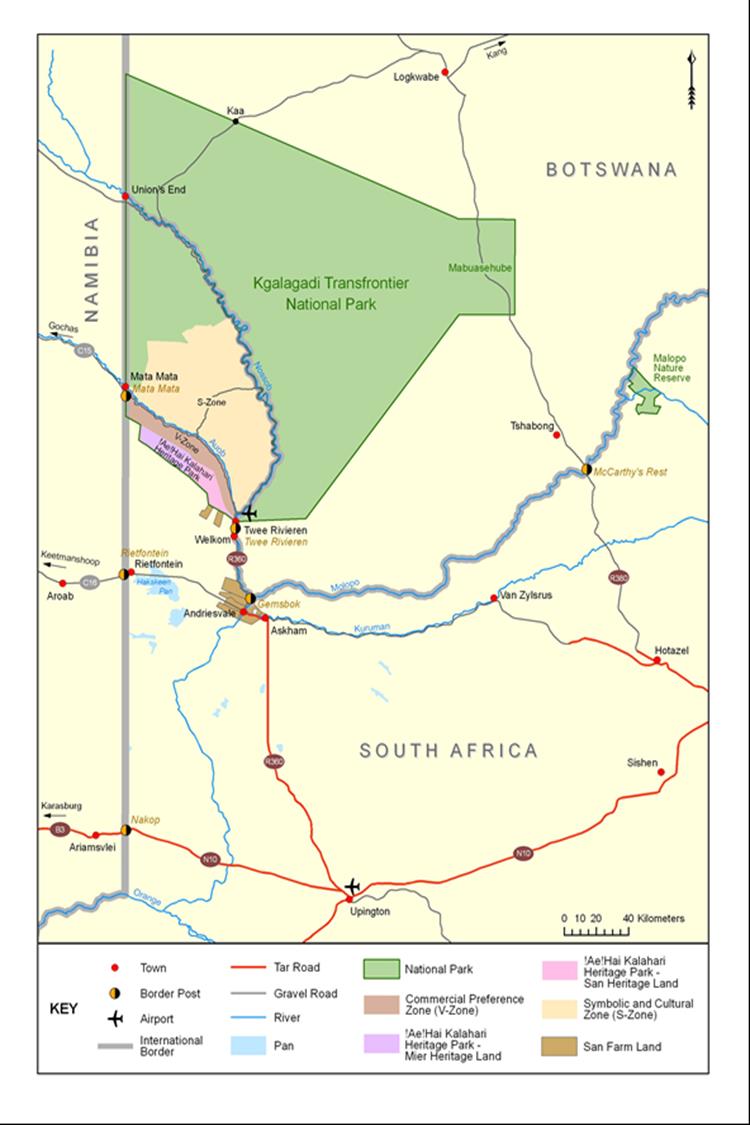
The community land is situated 60km’s south of the Tweerivieren camp of the Kgalagadi Transfrontier park in the Northern Cape. The area falls under the jurisdiction of Dawid Kruiper Local Municipality within the Siyanda region about 25km’s from the closest town, Askham. It is about a 200km’s north from Upington. The six farms is are located at the intersection of the main road from Upington to Rietfontein in Mier and the road from Noeniput to Tweerivieren.
The Kalahari system, in which the #Khomani properties falls, can be described as an arid to semi-arid area. The rainfall pattern is spatially and temporarily unavailable and highly erectic. Most rainfall is recorded in the summer, with the majority falling between January and April. The seasonal range of temperature in the Kalahari is large. In summer 45 degrees Celsius and in winter -10 degrees Celsius. The area is covered by Kalahari sands of which five groups are recognised. A characteristic of the Kalahari is the number of large shallow depressions or pans which holds water periodically during the wet season. The region has distinctive long sand dunes that run in parallel rows in a north-east, south-east direction in some places rise 15 – 30 metres above the dune valleys or so called “streets” between them. The area is underlain by large aquifer systems containing water that generally have a high level of salts not yet formally tested for human consumption but used by us as #Khomani.
The Kalahari system, in which the #Khomani properties falls, can be described as an arid to semi-arid area. The rainfall pattern is spatially and temporarily unavailable and highly erectic. Most rainfall is recorded in the summer, with the majority falling between January and April. The seasonal range of temperature in the Kalahari is large. In summer 45 degrees Celsius and in winter -10 degrees Celsius. The area is covered by Kalahari sands of which five groups are recognised. A characteristic of the Kalahari is the number of large shallow depressions or pans which holds water periodically during the wet season. The region has distinctive long sand dunes that run in parallel rows in a north-east, south-east direction in some places rise 15 – 30 metres above the dune valleys or so called “streets” between them. The area is underlain by large aquifer systems containing water that generally have a high level of salts not yet formally tested for human consumption but used by us as #Khomani.
Tourism
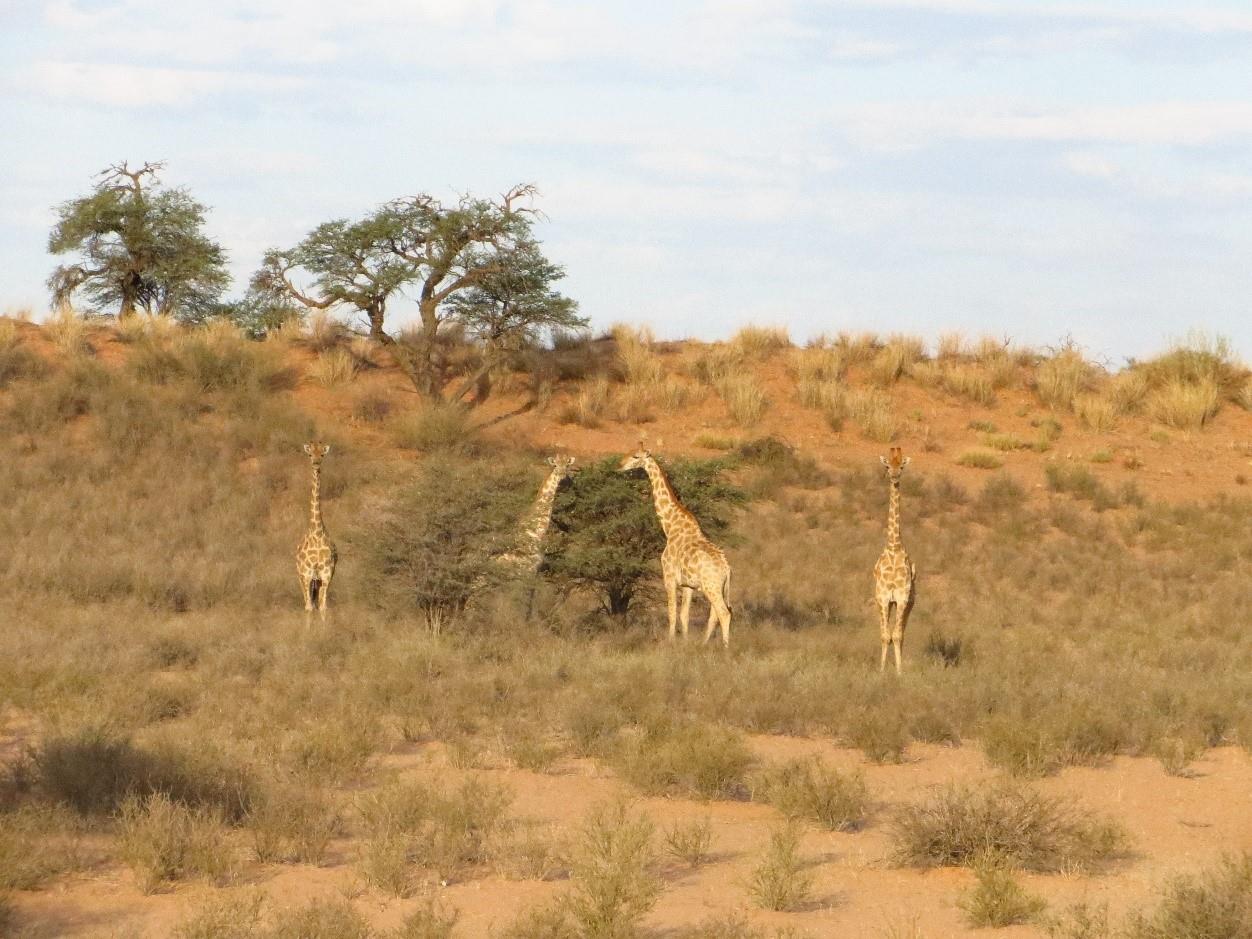
The Kgalagadi Transfrontier Park
Land Rights:
The Khomani San received ownership of 25000 hectares in the south east, and the Mier community received 28 000 hectares in the south west of the Park, which areas were to be proclaimed as Contract Parks and managed by SAN Parks. The San could utilize this land in any manner subject to the management plan.Preferential commercial rights:
The San received preferential commercial rights to the area between the contract parks and the Auob river. The Dawid Kruiper Lodge is currently developed in this area by SANParks in conjunction with the CPA.Symbolic and Cultural Use Rights:
The San were awarded cultural and heritage rights over the entire area of their original land claim, outside the contract park area. In this area we are entitled to visit, and to carry out various medicinal, gathering, cultural, educational and related activities, also subject to the management plan.The !Xaus Lodge:
Both the #Khomani San and the Mier were awarded 50% shares in a joint lodge situated in the contract park area in order to commemorate the manner in which they had cooperated during the negotiations. The lodge was funded by the Government, and the concession fees is shared three ways between the partners and SANParks as manager of the contract park.Community Park incentive:
SANParks offered to the #Khomani San a matching amount of up to R 500 000 for the specific establishment of a community game park outside the Reserve to be named the Traditional conservation area, Mier donated the land in the form of two farms.Community Gates:
Each community have the right to build and manage at least one gate into the park, subject to the Park’s strict regulations regarding entry and security.All of the above were is managed by a Joint Management Board comprised of the Mier, the #Khomani San and SANParks, in accordance with carefully laid down terms which is embedded in the a contractual agreement called the Brown bundle.
About the community
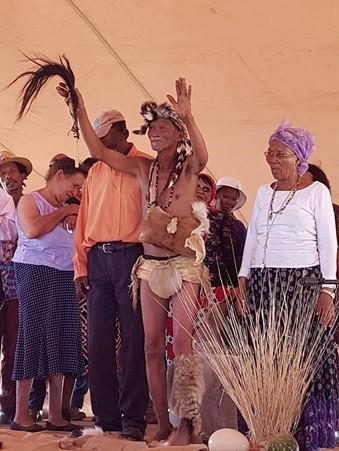
The community is governed by the Community Property Association (CPA) Committee which is elected according to our formal constitutional guidelines which also makes provision for a traditional leader who supports and implements traditional affairs.
The current traditional leader is Mr Petrus Vaalbooi and the CPA Committee members is as follows:
Chairperson Mr C Louw
Vice Chairperson: Mr A Raats
Secretary: Mr L Tieties
Treasurer: Mrs B Raats
Park Committee member: Mrs W Mondsinger
Park Committee member: Miss K Koper
Park Committee member: Mrs L Kruiper
Portfolio Member: Mr Johannes Springbok
Portfolio member: Mr N Dekoker
The current traditional leader is Mr Petrus Vaalbooi and the CPA Committee members is as follows:
Chairperson Mr C Louw
Vice Chairperson: Mr A Raats
Secretary: Mr L Tieties
Treasurer: Mrs B Raats
Park Committee member: Mrs W Mondsinger
Park Committee member: Miss K Koper
Park Committee member: Mrs L Kruiper
Portfolio Member: Mr Johannes Springbok
Portfolio member: Mr N Dekoker
Our Culture
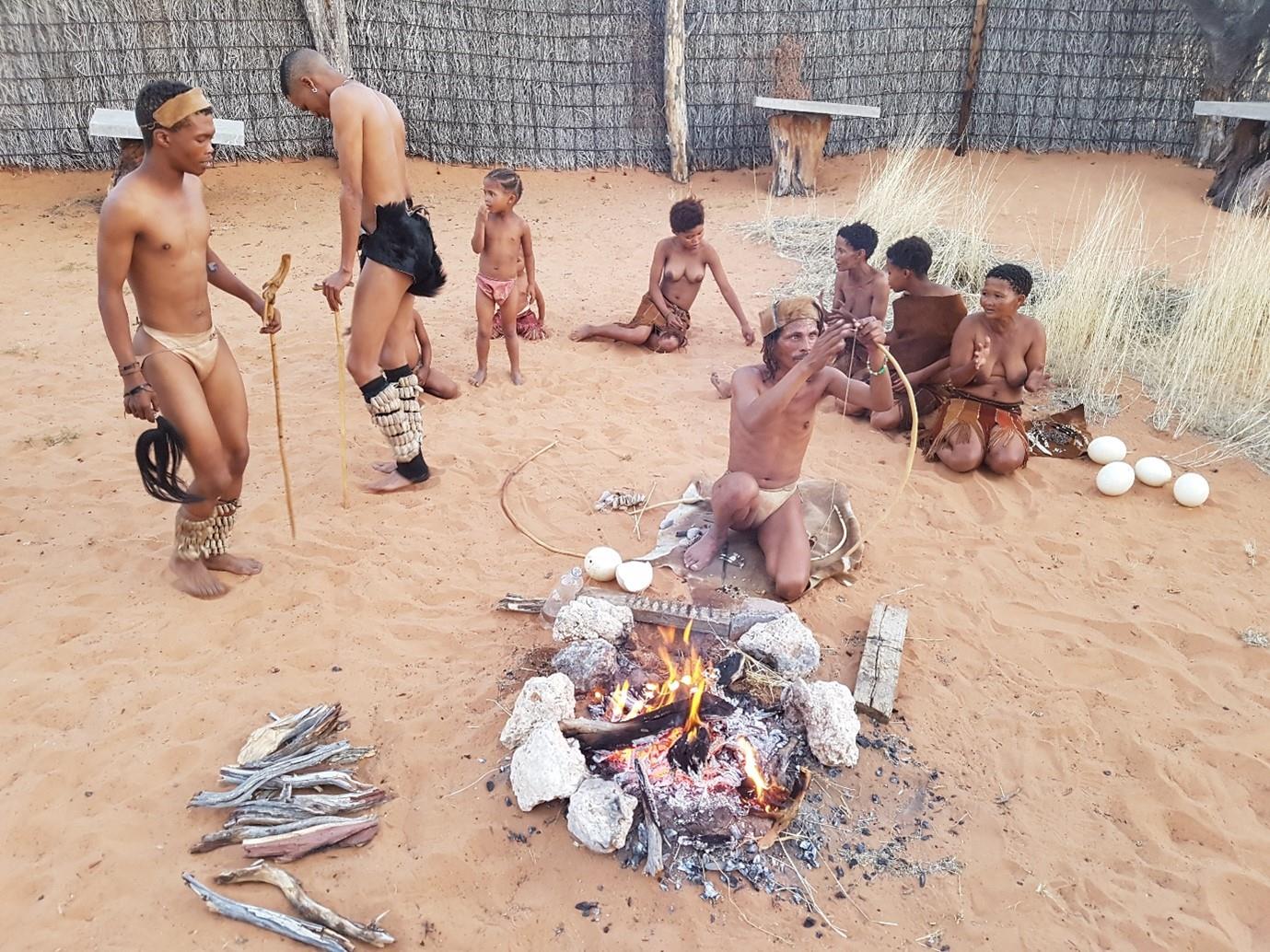
The #Khomani San are descended from several original San groups, including the ||Ng!u (close relatives of the !Xam, who lived south of the !Gariep River), the ‡Khomani who spoke the same language as the ||Ng!u but had a distinct lineage, the |’Auni, the Khatea, the Njamani and probably others whose names are now lost to us. Most San of this bloodline now speak Khoekhoegowap and/or Afrikaans as their primary language.
There are only five of the original 23 confirmed speakers (there is no reference point for this statement – in 2016, for example) of the ancient N|u language, constituting an important component of the few surviving aboriginal South African San. Approximately 1 500 adults are spread over an area of more than 1 000 square kilometres in the Northern Cape Province. Approximately 8002 people live in the northern reaches of Gordonia, at Witdraai, Askham and Welkom, just south of the Kgalagadi Transfrontier Park, and in the towns of Rietfontein, Upington, Loubos, Olifantshoek and surrounding villages and settlements (www.khomanisan.com), Despite the above mentioned facts it is still eminent that the #Khomani San embrace their culture tremendously and use it as their biggest commodity to the outside world and as bargaining power amongst clans. For example, different clans carry different amounts of knowledge and practice different parts of the culture. The stronger clan would batter this knowledge as the unified goal of the entire community is to keep their culture and traditions alive within the current context.
Christian religion was introduced to most families but a stronghold of #Khomani exist who only believe in the traditional spirituality and practices. Despite Christian religion introduction our community relies heavily on self-harvested and mixed herbs. All babies use the traditional mixed protection powder and the ancient tradition of messaging the pregnant female regularly until birth is practiced.
Most of the traditional practices is portrayed to visitors and none spiritual dances are arranged for visitors. All visitors to the community will agree that despite the social ills which exists like in all poverised or under developed communities that this community is a particularly vibrant community and uses remnants of their own culture to host and entertain their visitors respectfully.
There are only five of the original 23 confirmed speakers (there is no reference point for this statement – in 2016, for example) of the ancient N|u language, constituting an important component of the few surviving aboriginal South African San. Approximately 1 500 adults are spread over an area of more than 1 000 square kilometres in the Northern Cape Province. Approximately 8002 people live in the northern reaches of Gordonia, at Witdraai, Askham and Welkom, just south of the Kgalagadi Transfrontier Park, and in the towns of Rietfontein, Upington, Loubos, Olifantshoek and surrounding villages and settlements (www.khomanisan.com), Despite the above mentioned facts it is still eminent that the #Khomani San embrace their culture tremendously and use it as their biggest commodity to the outside world and as bargaining power amongst clans. For example, different clans carry different amounts of knowledge and practice different parts of the culture. The stronger clan would batter this knowledge as the unified goal of the entire community is to keep their culture and traditions alive within the current context.
Christian religion was introduced to most families but a stronghold of #Khomani exist who only believe in the traditional spirituality and practices. Despite Christian religion introduction our community relies heavily on self-harvested and mixed herbs. All babies use the traditional mixed protection powder and the ancient tradition of messaging the pregnant female regularly until birth is practiced.
Most of the traditional practices is portrayed to visitors and none spiritual dances are arranged for visitors. All visitors to the community will agree that despite the social ills which exists like in all poverised or under developed communities that this community is a particularly vibrant community and uses remnants of their own culture to host and entertain their visitors respectfully.
Our History
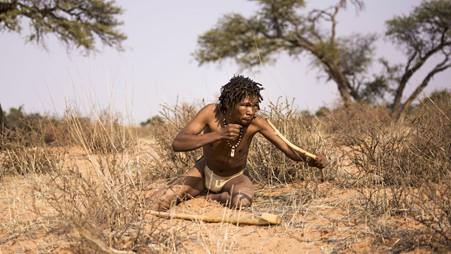
Introduction:
Out of Africa theory suggests that we the San or bushman (as many call ourselves proudly) are the ancestors of all modern humans, possibly a 120,000 years old. Hunter gatherers who existed over much of Southern Africa until waves of colonization pushed us into remote corners and genocide significantly reduced our numbers. Largely forced into serfdom and evicted from our traditional hunting and gathering grounds. It is still estimated that about 7500 San is still living in South Africa, Namibia, Botswana and Zambia.
Background:
When the Kalahari Gemsbok park was proclaimed in the 1930’s the livelihoods and freedom of 8 #Khomani san clans was taken away. Most members became dispossessed and dispersed to Namimibia, Botswana, others to nearby farms and many further afield in the Northern Cape province of South Africa.
In 1995 we lodged a landclaim for the restitution of 45 0000 in the Kalahari Gemsbok Park. After years of negotiation and verification, the claim was finally settled on 21st March 1999. At a moving ceremony attended by hundreds of San descendants as well as the world’s media, President Thabo Mbeki signed a land claim settlement agreement transferring the title deeds of six Kalahari farms (approximately 36 0000 ha) to the Khomani San CPA. In addition, 25 0000 ha within the Kgalagadi Transfrontier park.
Out of Africa theory suggests that we the San or bushman (as many call ourselves proudly) are the ancestors of all modern humans, possibly a 120,000 years old. Hunter gatherers who existed over much of Southern Africa until waves of colonization pushed us into remote corners and genocide significantly reduced our numbers. Largely forced into serfdom and evicted from our traditional hunting and gathering grounds. It is still estimated that about 7500 San is still living in South Africa, Namibia, Botswana and Zambia.
Background:
When the Kalahari Gemsbok park was proclaimed in the 1930’s the livelihoods and freedom of 8 #Khomani san clans was taken away. Most members became dispossessed and dispersed to Namimibia, Botswana, others to nearby farms and many further afield in the Northern Cape province of South Africa.
In 1995 we lodged a landclaim for the restitution of 45 0000 in the Kalahari Gemsbok Park. After years of negotiation and verification, the claim was finally settled on 21st March 1999. At a moving ceremony attended by hundreds of San descendants as well as the world’s media, President Thabo Mbeki signed a land claim settlement agreement transferring the title deeds of six Kalahari farms (approximately 36 0000 ha) to the Khomani San CPA. In addition, 25 0000 ha within the Kgalagadi Transfrontier park.

